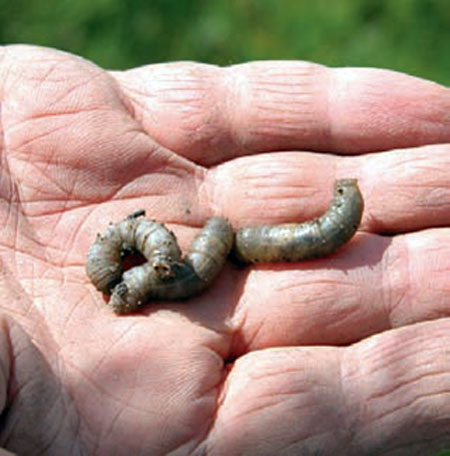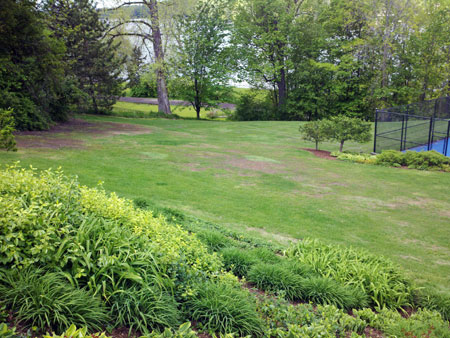European crane fly damage appearing now in Grand Rapids
European crane fly damage to lawns and golf courses is appearing now. To be better prepared, here are pictures of European crane fly larvae, adults, and turf damage.
Kevin Timmer of Tender Lawn Care in Grand Rapids, Mich., is seeing extensive damage from European crane fly that has appeared since mid-April. At these lawn sites the turf is extremely thin or dead in patches, with large crane fly larvae in the soil and on the surface. The large, “leather jacket” larvae are expected to continue feeding for two to three more weeks before pupating in the soil and emerging as an adult crane fly, which looks like a 1-inch long mosquito.
Now is a good time to look for crane fly damage in the southern half of the Lower Peninsula. The thin turf and accompanying excavation by skunks and raccoons looks like grub damage, but can be easily distinguished by the presence of the gray to tan-colored leather jackets (see photos below).

European crane fly adult. Photo credit: Dave Shetlar, OSU

European crane fly larvae. Photo credit: Dave Shetlar, OSU

European crane fly damage to a recreational lawn
in Grand Rapids, Michigan. This photo was taken
by Kevin Timmer (Tender Lawn Care) on May 11,
2012. The turf damage appeared in the last three weeks.
Infested lawns can be treated now with Sevin (or another turf product containing carbaryl) now to prevent additional damage this spring. However, to prevent damage late next fall and in spring of 2013, lawn care professionals or golf course superintendents will need use one of the following products and the indicated timing below. Timing is critical, as Kevin Timmer reported damage to several lawns this week that had been treated with imidacloprid in May last year (2011).
|
Product |
Correct Timing for European Crane Fly |
|
Sevin (carbaryl) |
In May or late fall when turf damage is discovered |
|
The following treatments are preventive: |
|
|
Acelepryn (Chlorantraniliprole) |
May (also protects against grubs and other turf pests) |
|
Arena (clothianidin) |
Late July and August (also protects against grubs) |
|
Merit (imidacloprid) |
Should provide protection when applied from late July to mid-August (also protects against grubs) |
|
Allectus (imidacloprid + bifenthrin) |
|
|
Aloft (clothianidin + bifenthrin) |
|
|
Meridian (thiamethoxam) |
Dr. Smitley's work is funded in part by MSU's AgBioResearch.



 Print
Print Email
Email
